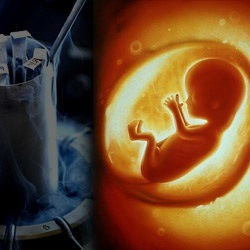Tragedy in a Test Tube
 The feminist movement, once personified by Betty Friedan and her soul sisters, founders of the National Organization for Women, has moved far beyond its stated goal of equality for women.
The feminist movement, once personified by Betty Friedan and her soul sisters, founders of the National Organization for Women, has moved far beyond its stated goal of equality for women.
Today, women contemplate and execute decisions that were once thought possible only within the context of a loving marriage between a man and a woman. Sarah Elizabeth Richards exemplifies such a female. Her article, “Why I Froze My Eggs (and You Should, Too),” is both fascinating and troubling.
Richards writes her personal tale of anguish as she frittered away her twenties and thirties in pursuit of romantic liaisons that, according to her, were not meant to be. She says she felt like she was losing her chance to have children even though she was not sure that she wanted them. In order to assuage her anxiety, she chose her 36th birthday to begin freezing her eggs.
But what caught my attention when reading her self-absorbed tale was this tidbit: “Doctors lack critical experience in making babies this way. According to a recent survey of U.S. fertility clinics that offer egg freezing, nearly half of doctors had never thawed a patient’s eggs to attempt a pregnancy. Even in the best of hands, there’s a real chance your frozen eggs might not work when you decide to start your family.”
Doctors making babies! Got it?
If this isn’t a perfect definition of what today’s culture has served up to women, then I do not know where one might find it.
The tragic reality contained in those few words cannot be denied. Start with the fact that the reproductive technology business easily smirks when considering that, for them, a “bundle of joy” is not just the baby who survives techno-creation, but also the big bucks that go into the bank account in the process. In the U.S., one cycle alone can cost between $6,500 and $15,000. Reports suggest that some women need more than one cycle in order to come up with more than one viable egg.
In addition, there is another cost that doesn’t surface in public discussion of this topic—the violation of nature itself. Man and woman together procreate a child by design—the design of nature. On the other hand, in a laboratory, men in white coats using test tubes, chemical solutions, ultrasound needles, microscopes, and “antifreeze” can extract and freeze human eggs until such time as a possible child is actually desired by the female who chose to have her eggs frozen.
Among the risks associated with this process is the false hope of the female who is devastated upon learning that her plans will not come to fruition because her implanted frozen egg will not survive. Her miscarriage will be sad, but the emotional cost to her and the greater cost to the culture cannot be ignored.
Today, egg freezing is not viewed as counter-cultural by most; in fact, it has been elevated to an art form. But at what cost? There is no question that, for many like Richards, the techno-fix empowers the ego dramatically as it sadly leaves the natural law in the dustbin created by the me generation.
The Catholic Church, in her wisdom, has defined egg freezing as “morally unacceptable.” This teaching does not derive from a callous disregard for the feelings a woman may experience when she fears that her biological clock might run out. Rather the Church, out of love for every human being’s eternal destiny, teaches in the framework of justice and mercy, compassion and self-sacrifice. After all, what one wants is not necessarily what one will receive.
Ultimately the Church’s concern is directed toward the soul at risk of devotion to technology instead of acceptance and respect for what nature has in store.

